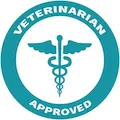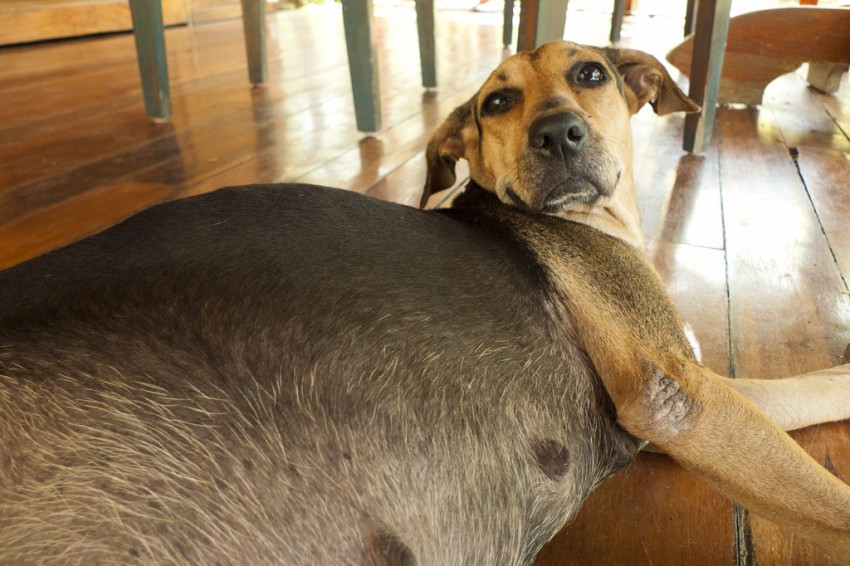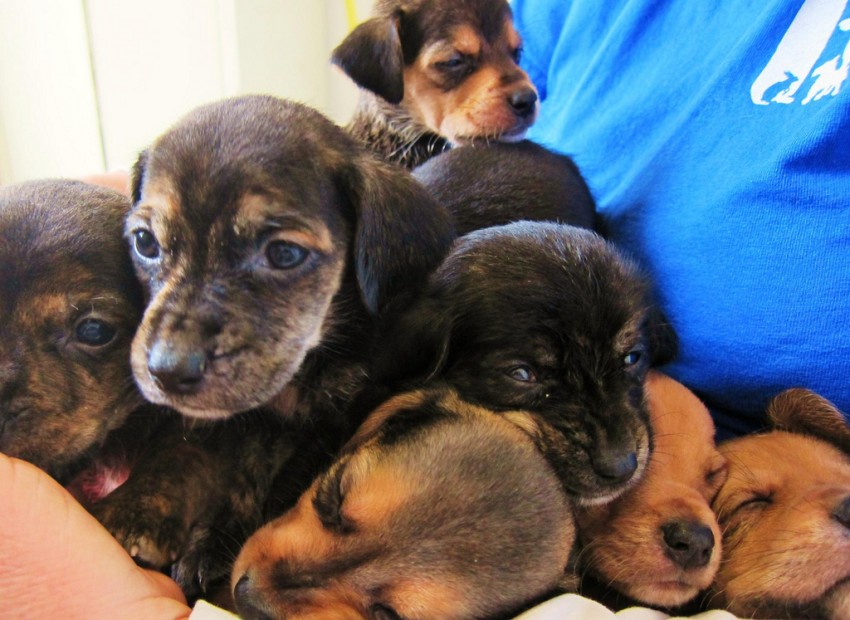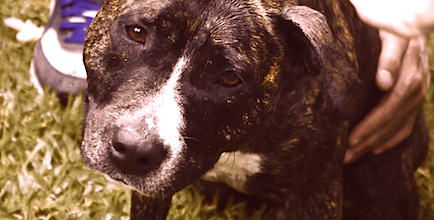Pregnant Dog Care: Essential Tips and Guidance for Every Step of the Journey
In this expert guide to pregnant dog care, you’ll learn what to expect, what to feed your pregnant dog, how to wean the puppies — and much more.

This expert guide to pregnant dog care was written by a veterinarian, Dr. Pippa Elliott, BVMS, MRCVS, with contributions from Kristine Lacoste and Kristen Youngs. It was reviewed for accuracy by Dr. Elliott and was last updated on November 11, 2024

- Accidents in Pregnant Dog Care: What You Need to Know
- Understanding Pregnant Dog Care and Preventing Unplanned Litters
- Planned Pregnancy and Responsible Pregnant Dog Care
- Unplanned Pregnancies and Pregnant Dog Care Considerations
- Pregnant Dog Care: How You Can Help During Pregnancy
- How to Confirm Pregnancy in Pregnant Dog Care
- Pregnant Dog Care: Essential Tips for a Healthy Pregnancy
- What to Feed a Pregnant Dog: Nutritional Tips for Pregnant Dog Care
- Frequency of Feeding in Pregnant Dog Care
- Deworming and Preventive Care of a Pregnant Dog
- Final Preparations for Delivery in Pregnant Dog Care
- How to Wean Newborn Puppies in Pregnant Dog Care
- What to Feed Puppies During Weaning in Pregnant Dog Care
- Caring for the Mom
- What to Expect During the Weaning Process in Pregnant Dog Care
- Frequently Asked Questions (FAQ)

Don’t leave your pet’s safety to chance
Sign up for Petful recall alerts today.

Accidents in Pregnant Dog Care: What You Need to Know
Accidents happen, and even the most careful pet owners can find themselves surprised. I remember one client who arrived in shock after her dog gave birth overnight. The twist? Her dog had never gone missing, so she hadn’t suspected a pregnancy.
After discussing the situation, it became clear that the dog’s brother also lived in the household. This is a common myth to address in pregnant dog care: animals don’t recognize “family” relationships the way humans do. When a female is in heat, nature takes over, regardless of kinship.
To prevent surprises like this:
- Never leave a female dog in heat with any male dog, even if they’re related.
- Supervise your dog carefully or consider keeping her separated to avoid accidental litters.
For more insights on this topic, read about whether pets from the same litter can mate.

Understanding Pregnant Dog Care and Preventing Unplanned Litters
Even the most vigilant pet owners can find themselves caught off guard by an unexpected pregnancy. With animal shelters already overwhelmed by dogs needing homes, avoiding unplanned puppies is essential in responsible pregnant dog care.
When Is a Dog Most Likely to Get Pregnant?
Mother Nature can be deceptive, especially during the heat cycle. A female dog’s discharge may disappear about a week into her heat, giving a false sense of security. However, this is the prime time for ovulation, making her highly susceptible to pregnancy if left unattended outdoors.
Key points about the estrus cycle:
- Female dogs generally come into heat twice a year, with each cycle lasting 3–4 weeks.
- During days 7–10 of the cycle, vaginal discharge appears.
- By days 10–14, the discharge may subside, but ovulation is likely occurring.
- Between days 14–28, the discharge reappears, becoming lighter toward the end.
Since some dogs can ovulate unpredictably, keeping her securely indoors or under supervision during her entire heat cycle is a key aspect of pregnant dog care.

Planned Pregnancy and Responsible Pregnant Dog Care
Thinking about breeding your dog? Planned pregnancies require serious consideration, as responsible pregnant dog care starts well before conception.
Breeding shouldn’t be based solely on appearances or the wishes of a friend. If your dog is a pedigree, she should be an excellent representative of her breed and free from genetic health issues. Additionally, animal shelters are already overwhelmed with dogs needing homes, so carefully assess if breeding is the right choice.
Consider the following aspects before moving forward:
- Health Risks: Pregnancy and birth carry inherent health risks for your dog, including potential complications.
- Veterinary Costs: You’ll need to be prepared for expenses like cesarean delivery or other medical care.
- Care Commitment: Nursing a litter requires significant time and effort, and it’s essential to ensure your dog’s health throughout the process.
For more on the challenges and responsibilities of deliberate breeding, read The Pitfalls of Breeding.
Unplanned Pregnancies and Pregnant Dog Care Considerations
Accidents happen, and even the most careful pet owners can find themselves dealing with an unplanned pregnancy. A determined dog might find a way into your yard, or your dog may slip her leash during a walk. If she’s in heat, there’s a high chance she could get pregnant in these situations.
When facing an unplanned pregnancy, consider the following:
- Evaluate Safety: Assess whether it’s safe and appropriate for your dog to carry the puppies to term.
- Size Differences: If a larger breed, like a Labrador Retriever, mates with a smaller dog, the resulting puppies might be too large for the mother to birth naturally.
- Veterinary Advice: Consult your veterinarian to discuss potential health risks and the best course of action for responsible pregnant dog care.
This approach ensures your dog’s well-being and helps you make informed decisions in unexpected situations.
Terminating an Unplanned Pregnancy: Options in Pregnant Dog Care
If your dog becomes pregnant unexpectedly, consult your veterinarian to discuss options. Yes, dogs can undergo abortion procedures, though treatment depends on the dog’s situation and the vet’s recommendations.
Abortion Options and Considerations:
- Pregnancy Confirmation: Some vets prefer confirming pregnancy before administering abortion drugs, while others may proceed without confirmation.
- Medication Options:
- Alizin: A commonly used drug, typically given in two injections 24 hours apart. Learn more about Alizin.
- Dexamethasone: Another injection option, though it may cause side effects like panting, excessive thirst, and increased urination. Read about dexamethasone.
- Prostaglandin F2 Alpha (PGF): A natural hormone your vet might administer, though it can result in panting, nausea, vomiting, and drooling. More on Prostaglandin F2 alpha.
- Spaying: Surgical spaying removes the fetuses and prevents future pregnancies. Learn about the spay procedure.
Aftercare and Precautions:
Abortion treatments may involve side effects, including discomfort, pain, and bleeding. Monitor your dog closely, and consider discussing pain management with your vet. Beware of online abortion medications—these are not only unregulated but can pose risks to both dogs and humans through skin contact. Always leave such treatments to professionals in a clinical setting.
Preventing Future Pregnancies:
Some dogs return to heat within 1–3 months after an abortion. To avoid future unplanned pregnancies, consider getting your dog spayed at the earliest opportunity. If you’re considering a breeding project, read The Pitfalls of Dog Breeding: Alice’s Story for insights.

Pregnant Dog Care: How You Can Help During Pregnancy
Are you considering breeding your female dog? Deciding to breed from a pet dog is a serious commitment, and it’s essential to weigh all the pros and cons. (For insights, see The Pitfalls of Breeding.)
If you’ve made an informed decision and chosen to proceed, know that responsible pregnant dog care is crucial for the well-being of both the mother and her puppies. From this point on, your role in her care can make a significant impact on her health and the puppies’ development.
Here are a few ways to help support your pregnant dog:
- Nutrition: Provide a high-quality diet that meets the needs of a pregnant dog. Consult your vet to ensure she’s getting all the essential nutrients.
- Veterinary Checkups: Schedule regular vet visits to monitor her health throughout the pregnancy.
- Exercise: Keep her active with light, gentle exercise. Avoid strenuous activities that could strain her.
- Comfortable Environment: Set up a quiet, comfortable space where she can rest undisturbed. This will also be useful as a birthing area later on.
Your dedication to her care can make a world of difference, ensuring a smoother pregnancy and healthier puppies.
How to Confirm Pregnancy in Pregnant Dog Care
After mating, there’s no immediate way to confirm pregnancy, as not all matings lead to conception. Around 28 days post-mating, you can look for reliable signs to determine if your dog is indeed pregnant. Here are the main options for confirming pregnancy:
- Physical Examination: Between days 28 and 35, your veterinarian may be able to feel the developing fetuses in the uterus, often described as a “string of pearls.”
- Ultrasound Scan: Starting from day 28, an ultrasound can detect the puppies’ heartbeats, offering confirmation of live fetuses.
- Blood Test: Also around day 28, a blood test can confirm pregnancy. Be aware that there’s a slight chance of a false negative if the litter is very small (1–2 puppies).
Each method can give you peace of mind and help you prepare for the next steps in pregnant dog care.

Pregnant Dog Care: Essential Tips for a Healthy Pregnancy
Providing the right care during your dog’s pregnancy can make a significant difference in the health of both the mother and her puppies. Here are some essential tips for responsible pregnant dog care:
- Manage Caloric Intake: Most fetal growth happens during the last two weeks of pregnancy, so extra calories aren’t needed early on. Overfeeding throughout the pregnancy can lead to a difficult birth.
- Avoid Calcium Supplements: Do not give calcium supplements during pregnancy, as this can increase the risk of eclampsia (milk fever). Learn more about milk fever in dogs.
- Keep Monitoring: Stay in close contact with your veterinarian and watch for any unusual changes in her health or behavior.
Following these guidelines will support a healthier pregnancy and contribute to an easier delivery.
What to Feed a Pregnant Dog: Nutritional Tips for Pregnant Dog Care
Feeding your pregnant dog a balanced diet is essential to support her health and her developing puppies. Here’s a guide to the best nutritional approach for pregnant dog care:
- Start with High-Quality Adult Food: If you haven’t already, switch to a premium adult dog food that’s balanced and nutritious.
- Monitor Intake for the First Six Weeks: For the first two-thirds of her pregnancy (up to about six weeks), focus on high-quality adult food and watch her weight to avoid overfeeding. Learn about the risks of overfeeding.
- Introduce Puppy Food by Week 4–5: By weeks four or five, begin mixing good-quality puppy food into her meals. The extra protein in puppy food supports the needs of both mother and puppies. Transition gradually over several days.
- Switch to Puppy Food Exclusively by Week 6: From week six onward, feed her only puppy food to ensure she receives the nutrition needed for a healthy pregnancy.
A balanced diet helps your pregnant dog stay healthy and provides the foundation for a smooth birth and healthy puppies.
Frequency of Feeding in Pregnant Dog Care
Adjusting meal frequency is an important aspect of pregnant dog care. As her pregnancy progresses, her feeding needs will change to accommodate the growth of her puppies.
- First 3 Weeks: Feed her at regular mealtimes, as the puppies are still small, and there’s no need for increased calories or extra meals.
- Middle 3 Weeks: Increase meals to 2–3 times per day. As the puppies grow, her belly will require more room, and additional meals can help manage her nutritional intake without overloading her stomach.
- Final 2 Weeks: Feed smaller meals more frequently, such as every 3–4 hours. The growing womb places pressure on her stomach, so frequent, smaller meals will help her stay nourished and comfortable.
This feeding schedule helps ensure your pregnant dog receives the right amount of nutrition without discomfort.
This amazing dog delivered 5 puppies on her own after being rescued:
Deworming and Preventive Care of a Pregnant Dog
Taking preventive measures is crucial in pregnant dog care to protect both the mother and her puppies from health risks. Here are some key steps to ensure her safety:
- Vaccinations: Ideally, vaccinate the mother before pregnancy to help pass immunity to her litter. However, if the pregnancy was unplanned, avoid vaccinating during gestation to reduce risk to the puppies. Learn more about pet vaccinations.
- Deworming Protocol: The recommended approach for deworming is to use fenbendazole daily from day 40 of pregnancy until two weeks after whelping. This helps reduce roundworm transmission from the mother to her puppies through the placenta or milk.
- Vet-Safe Products Only: Not all dewormers are safe for pregnant dogs. Always check with your veterinarian to ensure any parasite treatment you choose is safe for expectant mothers.
Following these preventive care steps helps provide a healthier environment for both mother and puppies.
Final Preparations for Delivery in Pregnant Dog Care
As your dog’s due date approaches, taking the right steps can ensure a safer delivery and a smooth start for her puppies. Here’s what to focus on in the last few weeks of pregnancy:
- Consider the Risk of Canine Herpes Virus: In the final three weeks, some experts recommend isolating the mother to minimize exposure to the canine herpes virus, which can cause fetal death. Learn more about canine herpes virus.
- Introduce the Whelping Box: Place a comfortable whelping box in a quiet area and encourage her to spend time there. Familiarizing her with this space helps reduce stress on the big day.
- Prepare for a Lifelong Commitment: While puppies bring joy, they’re also a big responsibility. Ensure you’re fully prepared to care for or find loving homes for the litter.
How Long Are Dogs Pregnant?
Dogs are typically pregnant for an average of nine weeks before giving birth. Knowing this timeline helps you prepare effectively for the delivery.

How to Wean Newborn Puppies in Pregnant Dog Care
Weaning is a key part of newborn puppy care, transitioning them from nursing on their mother’s milk to eating solid foods. In a home setting, the process typically begins between 3–4 weeks of age and should be gradual to ensure a smooth transition.
The Basics of Weaning
Weaning gradually shifts puppies from milk to solid food, usually over a month. This helps prevent the mother’s milk glands from becoming painfully overproduced and supports puppies as they develop critical social and behavioral skills by interacting with both mom and siblings.
Steps to Begin Weaning:
- Start at 3–4 Weeks: Begin introducing solid food when puppies are 3–4 weeks old. Aim to replace about 10% of their nutrition with food, while the remaining 90% still comes from nursing.
- Scheduled Feedings: Feed puppies several times a day. During feeding times, keep the mother and puppies in separate rooms to encourage independence and adapt them to the new food source. Here’s more if your puppy seems to whine or struggle with separation.
- Gradual Increase in Solid Food: Over the next four weeks, continue increasing the proportion of solid food until they are fully transitioned. By eight weeks, they should be entirely on solid food and comfortable with their new diet.
Maintaining Routine
A consistent feeding schedule helps establish good eating habits. Continue separating the mother and puppies during mealtimes to solidify their new routine and promote independence.

What to Feed Puppies During Weaning in Pregnant Dog Care
Choosing the right food is essential when weaning puppies off their mother’s milk. At this stage, puppies require a nutrient-rich, easily digestible diet to support their growth and development.
Steps for Preparing Puppy Meals:
- Start with a “Mushy” Texture: Puppies transitioning from milk to solid food need a soft, easily digestible consistency. Begin by mixing 12.5 ounces of puppy milk replacement with 2 cups of dry puppy food in a blender.
- Add Warm Water: Blend the mixture with warm water until it reaches a baby-food-like consistency. This amount should be sufficient to feed up to eight puppies, depending on the breed.
- Adjust Consistency Gradually: As the weaning process goes on, gradually reduce the amount of milk replacement and increase the amount of dry food. Start blending to a thicker consistency to help puppies adapt to solid food. Learn more about feeding during weaning.
- Transition by Week 7–8: By 7–8 weeks old, puppies should be able to handle solid food without the need for blending or milk replacement.
Following these feeding steps will help ensure a healthy transition for puppies as they adapt to solid food.
Caring for the Mom
The mother also needs to be looked after and cared for during this time.
Most breeders will start feeding mothers their chosen puppy food once they find out she’s pregnant. Doing so helps the mother gain the right amount of weight for her pregnancy.
After the puppies are born and the weaning process starts, the mother needs to be switched back to her regular dog food. This should also happen gradually to prevent any stomach upset:
- Try replacing 1/4 cup of her puppy food with adult food from the start, and increase for several weeks to a month.
- By the time the puppies are fully weaned, the mom should be eating her regular adult food.
No one ever said weaning puppies wasn’t messy:
What to Expect During the Weaning Process in Pregnant Dog Care
Weaning is a gradual process, and patience is key. Puppies may learn at different paces, so stick to a routine and allow each puppy the time they need to adjust.
Tips for a Smooth Weaning Experience:
- Stay Consistent: Follow a regular schedule, as consistency helps each puppy gradually adjust to solid food.
- Expect Some Mess: Weaning can be a messy process. Curious and inexperienced puppies often create spills with their food mixtures, but this is completely normal.
- Let Mom Assist: The mother will instinctively help clean up, licking any remaining food. Clear up what you can first, then allow her to finish the job.
- Consult Your Vet Regularly: Especially if this is your first time weaning puppies, keep in touch with your veterinarian. They can provide expert guidance on care, nutrition, and any supplies needed for the puppies.
Participating in the weaning process is a unique experience that showcases the natural instincts of both mother and puppies. With patience and consistency, you’ll help set each puppy up for a healthy start.
Frequently Asked Questions (FAQ)
How do you take care of a pregnant dog?
Provide a balanced diet, regular vet checkups, gentle exercise, and a comfortable space for rest.
What should dogs avoid when pregnant?
Pregnant dogs should avoid strenuous activities, vaccinations, and non-vet-approved medications or supplements.
What do you feed a pregnant dog?
Feed a pregnant dog high-quality adult food initially, transitioning to nutrient-rich puppy food by the final third of pregnancy.
Is it okay to bathe a pregnant dog?
Yes, it’s okay to bathe a pregnant dog, but ensure the experience is calm and use gentle, dog-safe shampoo.









